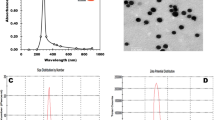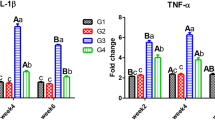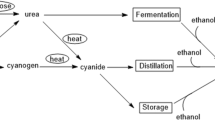Abstract
The serum and hepatic enzymes of rats were studied after exposed to country made liquor (CML) along with two chelating agents (glutathione and Selenium). There was a significant increase in several serum enzyme levels (viz., aspartate transaminase, alanine transaminase, alkaline phosphatase, sorbitol dehydrogenase, glutamate dehydrogenase, bilirubin) and decrease in various hepatic enzymes (Succinic dehydrogenase, Glucose 6-phosphatase, 5'Nucleotiease, Acid phosphatase, Acid ribonuclease, Cytochrome P-450) due to repeated administration of CML (2ml/100g of body weight). Results of this study revealed that the GSH and Se could give a significant protective action in serum and hepatic enzymes of CML exposed rats.
Similar content being viewed by others
References
Nevins, CL, Malaty H, Velez ME, Anand BS. Interaction of alcohol and hepatitis C virus infection on severity of liver disease. Dig Dis and Sci 1999: 1236–42.
Rainke LA, Mc Cay PB. Spin trapping studies of alcohol initiated radicals in rat lever; influence of dietary fat. In American society for Nutrition Sciences annual meeting Journal of Nutrition, 1997: 127.
Bellentani S, Saccocio G, Masutti F, Giacca M, Miglioli L, Monzoni A, Tiribelli C. Risk factors for alcoholic liver disease. Addict Biol 2000; 5(3): 261–8.
Fickert P, Zatloukal K. Pathogenesis of alcoholic liver disease. In: Zernig G, Saria A, Kurz M, Malley SSO, editors. Handbook of alcoholism, CRS Press, 2000; 317–23.
Yang Z, Dovis A, Harley Z, Stone C, Bosten W. Catalytic efficiency of human alcohol dehydrogenase for retinal oxidation and retinol reductions. Alc Clin Exp Res 1994; 18(3): 587–91.
National Institute of Health Guide for the Care and Use of laboratory Animals. DHEW Publication (NIH), revised, Office of Science and Health Reports, DRR/NIH, Bethesda, USA, 1985.
Reitman S, Frankel S. A colorimetric method for the determination of serum glutamic oxaloactic acid and glutamic pyruvic transaminases. Am J Clin Pathol 1957; 28: 56–63.
Kind PRN, King EJJ. Estimation of plasma phosphatase by determination of hydrolyzed phenol with aminopyrines. J Clin Pathol 1954; 7: 332.
Gerlach U, Hiby W. Sorbitol dehydrogenase. In: Bergmeyer H. U, editors. Methods of Enzymatic analysis. Vol. II. Verlag Chemie Weinheim, Academic Press, New York. 1974; 569–73.
Malloy HT, Evelyn KA. The determination of bilirubin with the photometric colorimeter. J Biol Chem 1937; 119: 481–90.
Green DE, Mii S, Kohout PM. Studies on the terminal electron transport system. I. Succinic dehydrogenase. J Biol Chem 1955; 217: 551–67.
Baginski ES, Foa PP, Zak B. Glucose-6-phosphatase. In: Bergmeyer H. U, editor. Methods of Enzymatic analysis. Vol. II. Verlag Chemie Weinheim, Academic Press, New York 1974; 876–80.
Aronson NN Jr, Touster O. Isolation of rat liver plasma membrane fragment in isotonic sucrose. In: Fleischer S, Packer L, editors. Methods in Enzymol, Vol. 31. Academic Press, New York 1974; 90–2.
De Duve C, Pressman BC, Gianetto R, Wattiaux R, Appelmans F. Tissue fractionation studies. Intercellular distribution pattern of enzymes in rat liver tissue. Biochem J 1955; 60: 604–17.
Schneider WC, Hogeboom GH. Intracellular distribution of enzymes. Further studies on the distribution of cytochrome C in rat liver homogenates. J Biol Chem 1950; 183: 123–8.
Omura T, Sato R. The carbon monoxide binding pigment of liver microsomes. J Biol Chem 1964; 239: 2370–8.
Kumar G, Sharmila Banu G, Kannan V. Rajasekara Pandian M. Antihepatotoxic effect of â-carotene on paracetamol induced hepatic damage in rats. Ind J Exp Biol 2005; 43: 351–5.
Chhya Gadgoli, Mishra SH. Antihepatotoxic activity of pmethoxy benzoic acid fromCapparis spinosa. J Ethnopharmacol 1999; 66: 187–92.
Tanaka K, Lizuka Y. Suppression of enzyme release from isolated rat liver lysosomes by non-steroidal antiinflammatory drugs. Biochem Pharmacol 1968; 17: 3023–32.
Mandal PK, Bishayee A, Chatterjee M. Stimulation of tissue repair byMikania cordata root extract in carbon tetrachloride induced liver injury in mice. Phytother Res 1993; 7: 103–5.
Yeragi SG, Rana AM, Koli VA. Effect of pesticides on protein metabolism of MudskipperBoleophthalmus Dussumieri. J Ecotoxicol Environ Monit 2003; 13: 211–4.
Bradbury SP, Mc Kim JM, Coats JR. Physiological responses of rainbow trout, Salmogairdneri to acute fenvalerate intoxication. Pest Biochem Physiol 1987; 27: 258.
Lieber CS. Alcohol and liver in medical disorders of alcoholism. In: Pathogenesis and Treatment, Smith LH, editor. W.B. Sounders Co., Philadelphia. 1982; 259–64.
Renzoni R. Mercury and selenium in the Mediterranean Sea. 5th Joint oceanographic assembly abstracts. Vol. I. Department of Fisheries and Oceans, Scientific Information and Publication Branch, Ottawa, 1982; 53.
Chandy JP, Patel B. Do selenium and Glutathione (GSH) detoxify mercury in marine invertebrates? Effects on lysosomal response in the tropical blood clamAnadars granosa. Dis Aqua Org 1985; 1: 39–47.
Kumar G, Sharmila Banu G, Kannan V. Effects of Arrack on liver protein ofMus musculus. J Ecobiol 2006; 18: 321–4.
Author information
Authors and Affiliations
Corresponding author
Rights and permissions
About this article
Cite this article
Kumar, G., Banu, G.S. & Pandian, M.R. Biochemical activity of selenium and glutathione on country made liquor (CML) induced hepatic damage in rats. Indian J Clin Biochem 22, 105–108 (2007). https://doi.org/10.1007/BF02912891
Issue Date:
DOI: https://doi.org/10.1007/BF02912891




